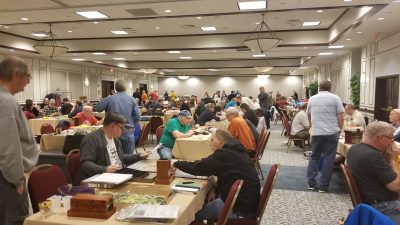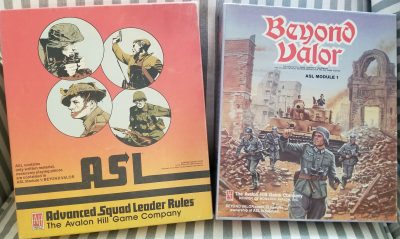An Introduction to Advanced Squad Leader
By David Garvin
As gamers from across the country and around the world settled on Bowie, Maryland last month, there was a buzz in the air. The numbers showing up seemed to be greater than ever and this was to be confirmed by the organizers: 190 registered players. This was by far the greatest Winter Offensive held by (MMP).

Winter Offensive is the annual gaming tournament held every year by the publishers of Advanced Squad Leader (ASL).
It is an open format tournament that features many games into the ubiquitous ASL. Many of these cover various battles of the US Civil War. But there is no doubting the fact that the big draw for Winter Offensive is ASL.
Every year at Winter Offensive, MMP will release a scenario pack and this year was no different. But the big draw this year was the release of their historical module, Red Factories. This new release included the very first historical ASL (HASL) module, Red Barricades and added to it Red October. This HASL depicts battles around the factory district in Stalingrad in October and November 1942.

So, what exactly does a hex-and-counter game have to do with miniature gaming? Actually, it has everything to do with it.
The game that eventually evolved into ASL – Squad Leader – was originally designed to be a miniatures game. The designer, John Hill, decided instead to go with a hex-and-counter game and the result was a classic.
It was released in 1977 and it ended up selling well in excess of 100,000 copies. If sale of the follow-on modules – Cross of Iron, Crescendo of Doom and GI: Anvil of Victory – are combined with the sales of ASL, then the numbers got into the millions by 1997.
In 1985, the first ASL module, Beyond Valor was released. Due to some final editing, the rule book wasn’t released until early 1986. In Beyond Valor, players got the entire orders of battle for the Wehrmacht and Soviet Armies, as well as the Waffen-SS.
Finnish Infantry and Partisans were also included. Also included in Beyond Valor were the various information counters necessary to track events and actions in the game. The rules were not laid out in programmed instruction as the original game set was; the designers assumed that everyone would be able to switch up to ASL with relative ease.
Instead, the rules were organized into various chapters in a three-ring binder with pages being able to be replaced as errata were developed. Initially, there were six chapters: Infantry and basic game, Terrain, Ordnance, Vehicles, Design your Own and AFV and Ordnance notes and finally Deluxe ASL. As opposed to being a rule book explaining how to play the game, it was instead laid out as a reference manual and it made learning the game difficult for new players.

This shortcoming was noted and in the second module, Paratrooper, this was address by adding Chapter K. It was written by noted play tester Jim Stahler and was the training manual. It was written as a conversation between a drill sergeant and his recruits (the player). This chapter remains today and has expanded from the original 24 pages to 43. In 2004, MMP release its first Starter Kit, a pared-down version of ASL. This was followed up by 2 more, with a 4th on the way. As well, the game has now expanded to include every conceivable theater of the Second World War. Additionally, there was a release in 2017 that expanded the system to Korea with Forgotten War.
As previously mentioned, ASL was originally conceived as a miniatures game. With the release of Streets of Fire in late 1985. The hexes were much larger at 2.2″ and was intended to use 1:285 scale miniatures for the vehicles. Two modules were released, the second based on fighting in Normandy. This stream of ASL became very niche; however, in 2018, MMP’s Winter Offensive pack included four more Deluxe sized boards with associated scenarios.
The real draw of ASL isn’t so much the variety of battles it can depict, but its series of Historical modules, 12 in all. Instead of the generic “geomorphic” boards that represent typical terrain, the Historical Modules, HASLs, have maps based on the actual terrain over which the various battles were fought.
As mentioned, the first HASL, Red Barricades, was set in the factory district of Stalingrad and players were able to fight a campaign of several days – weeks even – with the results of one battle affecting the start of the next. HASLs went on to cover the Battle of the Bulge, the assault on Pegasus Bridge, the drive for the bridges at Arnhem and various battles in the South Pacific. The main focus, however, seems to be centered on Stalingrad. There are now 3 HASL modules based on this battle: Red Barricades, Red October and Valor of the Guards.

Independent third-party companies have made a number of scenario packs, some ranging from the amateurish efforts by Critical Hit to the real gems produced by . There are some very good international third-party products (3PP), including out of Victoria, British Columbia to out of France.
So, getting back to the actual game, what does this have to do with the price of tea in China? The short answer is this: everything. At its core, ASL is a miniature game that uses counters instead of scale models.
The difference between it and miniature games is probably to be found in the maps it uses. From the generic “geomorphic” maps (that is, they can be arranged with other maps in an almost limitless fashion) to the historical ones, movement and fire are regulated by the hexagons.
So, as mentioned, back in January, there was a gathering of gaming faithful in Bowie. This is not an uncommon event. It is actually the norm to find at least 1 ASL tournament going on somewhere in the US every month of the year. This coming June will see the local ASL gaming club, the DC Conscripts, conducting its 2nd annual ASL tournament, “Human Wave” in Tysons Corner. This is a three-day event that will see players from up and down the Eastern Seaboard coming together for some gaming. If you’re interested, have a look at the tournament . Everything you need to see is there.
If you’re interested in learning ASL, or even just curious to find out more about it, Human Wave 2019 is the perfect venue for you. If you’re a gamer who is into miniature games, you will note one main difference in the manner in which the battle is played out: the interaction during a person’s movement phase. As a player moves his units – one unit at a time – the defending player has the option to fire – or not – as that unit moves. There is no moving units back. This is the defining feature of ASL: the chess match of wits between players.

So, come on out in June. If nothing else, you’ll be able to spend some time watching some fellow gamers enjoy their preferred game.
We will be including a tournament dedicated to the Starter Kit only, and plenty of our players would be more than happy to help mentor you in your first match, should you wish to give it a try. And who knows? You may even like it! No, ASL is definitely not a miniatures game, but the feel of such a match is there, and if you’re a true student of history, ASL may just be the appeal you’re looking for.
David Garvin is an active-duty Canadian Army infantry officer, serving in The Royal Canadian Regiment. He is currently stationed in Northern Virginia as a Liaison officer and is also a member of the DC Conscripts ASL Gaming Club. He’s been gaming since 1983 and his favorite is, in case you couldn’t tell, is Advanced Squad Leader

Nice write-up, but I respectfully disagree with your statement “The real draw of ASL isn’t so much the variety of battles it can depict, but its series of Historical modules”. To me the historical modules are a nice extra. The real draw is ABSOLUTELY its variety.
Hi Michael. Great point. I think I ought to have said “The *main* draw of ASL *for me* isn’t so much the variety…” etc.
I think I was trying to get to the historical aspect of ASL as its appeal. And you’re right, the variety is quite appealing. Sick of East Front heavy metal? Go fight partisans in Yugoslavia, or an infantry-only battle in Normandy, or clear bunkers in Saipan, etc.
Cheers!
David